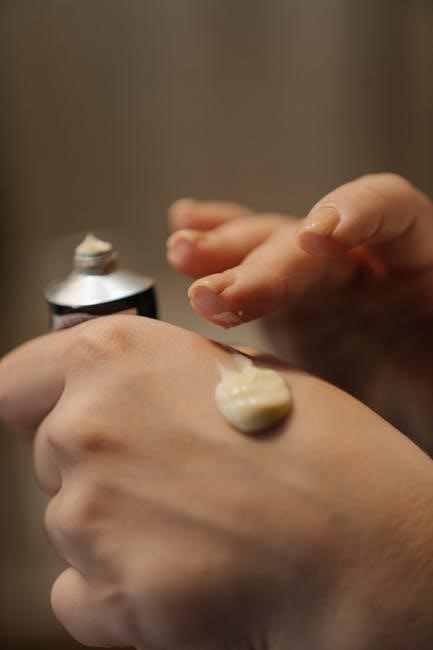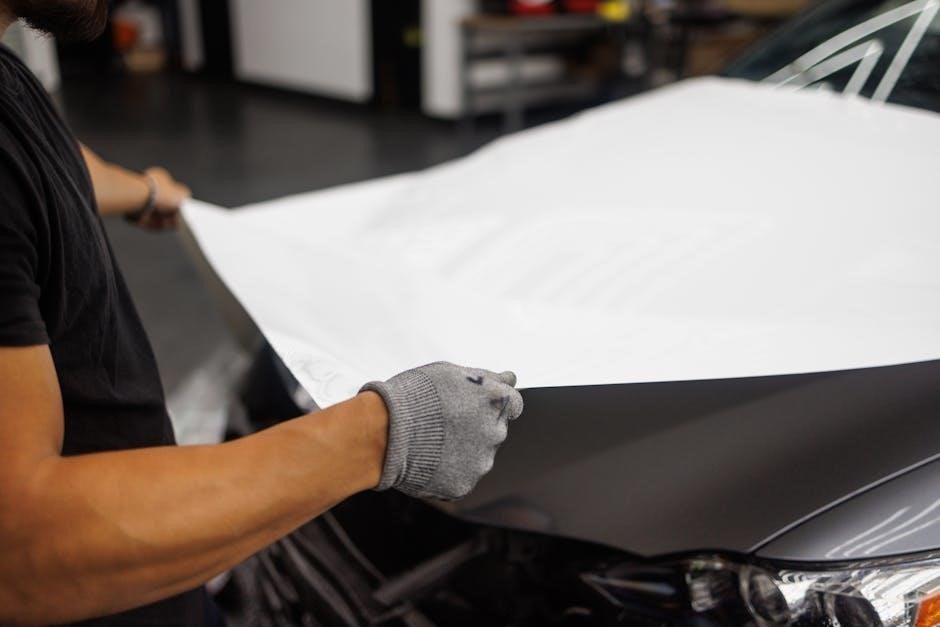Learning vinyl decal application is easy with online guides and tutorials, providing step-by-step instructions for a successful project, using various tools and techniques to achieve professional results quickly and easily always.
Importance of Following Instructions
Following instructions is crucial when applying vinyl decals, as it ensures a successful and long-lasting result. The application process can be simple, but it requires attention to detail and the right techniques. By following the instructions, you can avoid common mistakes, such as air bubbles or misaligned decals. Proper application also depends on the type of vinyl and surface being used. The instructions will guide you through the preparation and application process, including cleaning and drying the surface, applying the transfer tape, and smoothing out the decal. Additionally, the instructions will provide tips on how to handle the decal, such as letting it cure for a certain amount of time before using it; This will help prevent the decal from peeling off or fading quickly. Overall, following the instructions is essential to achieve a professional-looking result and ensure the longevity of the vinyl decal. With the right instructions, you can create and apply custom adhesive vinyl decals with ease and confidence.
Tools Required for Application
The right tools are essential for a successful vinyl decal application. A cutting machine, cutting mat, and weeding tool are necessary for preparing the surface and applying the decal. Transfer tape is also required to transfer the decal to the surface. A squeegee or similar tool is used to smooth out the decal and remove any air bubbles. Additionally, a snap knife or other cutting tool may be needed to trim excess vinyl. Application fluid can also be used to speed up the drying time and ensure a strong bond between the decal and the surface. It is also recommended to have rubbing alcohol on hand to clean the surface before application. Having all the necessary tools on hand will make the application process easier and more efficient. With the right tools, you can achieve a professional-looking result and ensure the longevity of the vinyl decal. The tools may vary depending on the type of vinyl and surface being used, but having the basics will get you started on the right foot.

Preparation for Vinyl Decal Application

Proper preparation is key to successful vinyl decal application always requiring attention to detail and cleanliness procedures.
Cleaning the Surface
Cleaning the surface is a crucial step in the vinyl decal application process, as it ensures a strong bond between the decal and the surface. To clean the surface, use rubbing alcohol and a soft cloth to wipe away any dirt, dust, or other substances that may be present. This will help to prevent air bubbles from forming under the decal and ensure that it adheres properly. It’s also important to make sure the! surface is dry and free of any oils or waxes, as these can interfere with the adhesive. By taking the time to properly clean the surface, you can help to ensure a successful vinyl decal application. The surface should be cleaned thoroughly, paying attention to any areas where the decal will be applied. A clean surface is essential for a strong and lasting bond between the decal and the surface, and will help to prevent the decal from peeling or fading over time.
Drying the Surface
After cleaning the surface, it’s essential to let it dry completely before applying the vinyl decal. This step is critical in ensuring a strong bond between the decal and the surface. Any moisture or humidity on the surface can interfere with the adhesive, causing the decal to peel or bubble. To dry the surface, simply let it air dry or use a soft cloth to gently wipe away any excess moisture. It’s also important to ensure that the surface is free of any dust or debris that may have accumulated during the drying process. By allowing the surface to dry completely, you can help to prevent any issues with the decal application and ensure a long-lasting bond. The surface should be dry to the touch and free of any streaks or residue before applying the vinyl decal. This will help to ensure a successful application and a professional-looking finish. Proper drying of the surface is a crucial step in the vinyl decal application process.

Applying the Vinyl Decal
Apply the vinyl decal using transfer tape, smoothing out air bubbles and wrinkles carefully always with a squeegee or similar tool for best results and a professional finish every time easily.
Understanding the Decal Layers
When receiving a vinyl decal, it typically arrives in a three-layer sandwich, consisting of the decal itself, a backing paper, and a transfer tape. The decal is visible through the backing paper, which resembles masking tape or clear plastic. The transfer tape is used to apply the decal to the desired surface, allowing for a smooth and bubble-free application. It is essential to understand the different layers and their purposes to ensure a successful application. The backing paper protects the decal during shipping and storage, while the transfer tape enables the decal to be applied to the surface without air bubbles or wrinkles. By recognizing the different layers, individuals can properly handle and apply the decal, resulting in a professional-looking finish. This understanding is crucial for achieving a successful vinyl decal application, and it is recommended to follow the provided instructions carefully to ensure the best results. Proper layer management is key to a successful application.
Using Transfer Tape
Transfer tape is a crucial component in the vinyl decal application process, allowing for a smooth and bubble-free application. The tape is applied over the decal, covering the entire surface, and is then used to transfer the decal to the desired surface. It is essential to apply the transfer tape carefully, ensuring that it is centered and smooth, with no air bubbles or wrinkles. The tape should be applied in a way that allows for easy removal, without leaving any residue on the decal. By using transfer tape, individuals can achieve a professional-looking finish, with the decal applied smoothly and evenly. The transfer tape helps to prevent air bubbles and wrinkles, resulting in a smooth and flat decal application. Proper use of transfer tape is vital for a successful vinyl decal application, and it is recommended to follow the provided instructions carefully to ensure the best results. This will help to achieve a professional-looking finish.

Tips for Successful Application
Following instructions and using quality materials ensures a successful vinyl decal application with a professional finish always and easily every time with great results and satisfaction, using tools.
Allowing the Decal to Cure
To ensure the decal lasts as long as possible, it is essential to allow it to cure for a sufficient amount of time. The curing time may vary depending on the type of vinyl and the surface it is applied to. Generally, it is recommended to let the decal cure for at least 72 hours before exposing it to water or other elements. This will help the adhesive to fully bond with the surface, creating a strong and durable bond. By allowing the decal to cure, you can help prevent it from peeling or fading prematurely. It is also important to note that the curing time may be affected by factors such as temperature and humidity. In some cases, it may be necessary to let the decal cure for a longer period of time to ensure optimal results. Following the recommended curing time will help to ensure a successful application. Proper curing is crucial for a long-lasting decal.
Factors Affecting Decal Longevity
Several factors can affect the longevity of a vinyl decal, including the type of surface it is applied to, the quality of the vinyl, and the environmental conditions it is exposed to. The surface preparation and cleaning before application also play a crucial role in determining the decal’s lifespan. Additionally, the amount of sunlight and moisture the decal is exposed to can cause it to fade or peel prematurely. The type of vinyl used, such as indoor or outdoor vinyl, can also impact its durability. Other factors like temperature, humidity, and exposure to chemicals can also affect the decal’s longevity. Understanding these factors can help individuals take necessary precautions to extend the life of their vinyl decals. By considering these factors, users can choose the right type of vinyl and take steps to protect their decals from damage, ensuring they remain vibrant and intact for a longer period. Proper care and maintenance can also help to extend the life of the decal.
